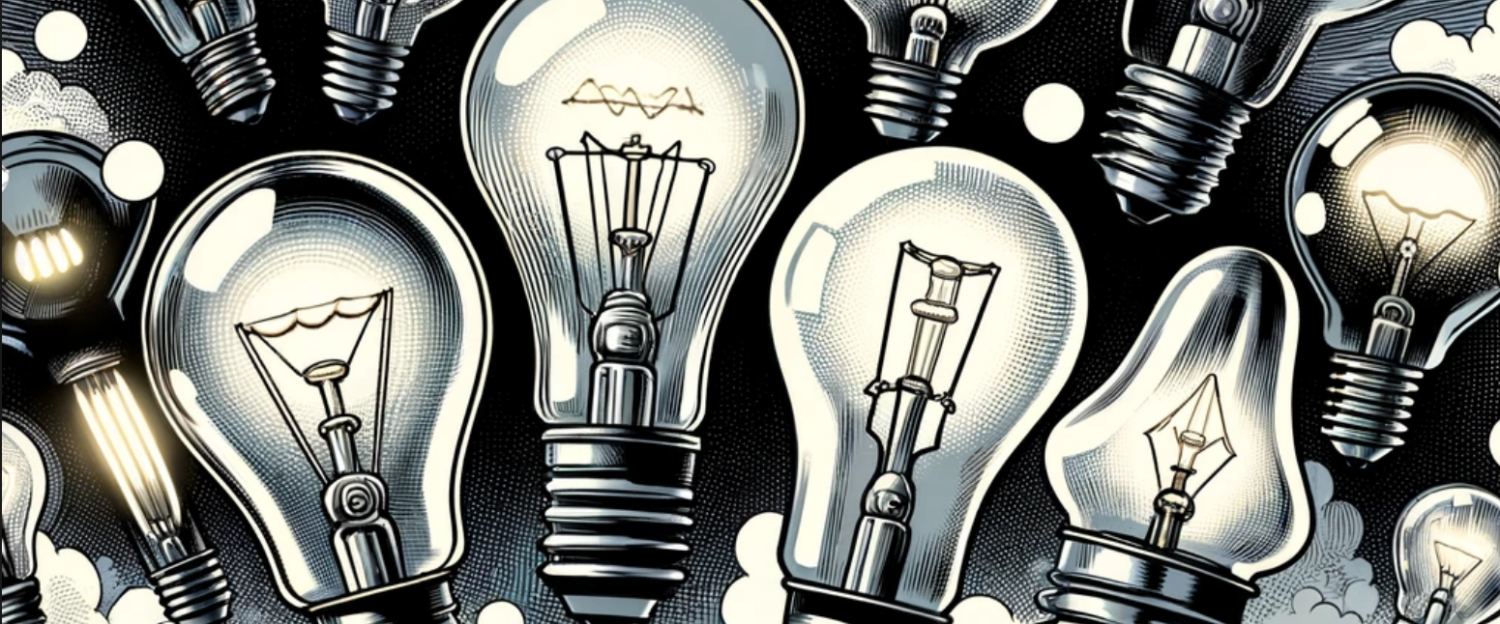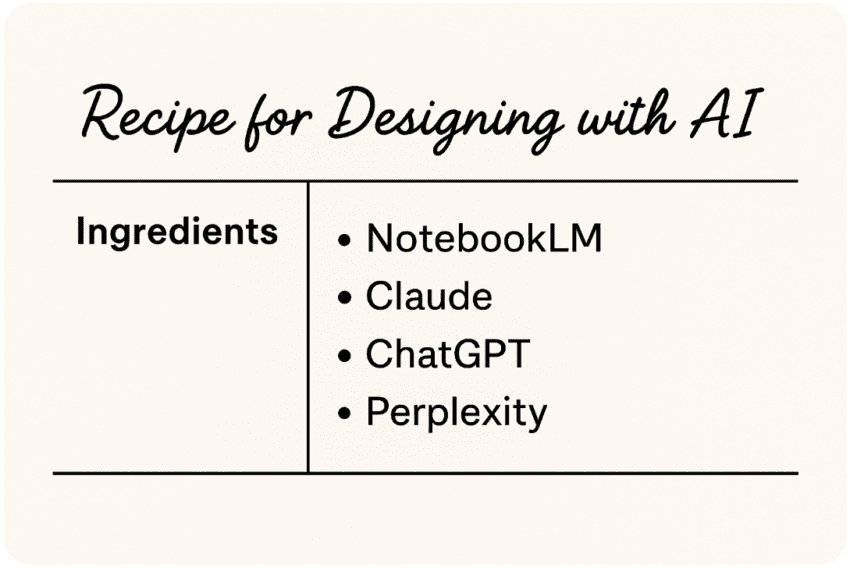We’ve all heard the promise. Write a detailed enough prompt, pop it into ChatGPT or Claude and watch a complete solution appear. But that is often a recipe for disaster my friend.
The real AI super power isn’t in finding the perfect AI tool or even writing the perfect prompt (although good prompting really helps). Much like cooking a great meal, it’s in knowing when to use which of your tools and most importantly, how to apply your own expertise to guide and validate what they produce.
The challenge
I needed to design a workshop for a small virtual team going through reorganization. The goal was to collectively define team culture using Erin Meyer’s 8 Cultural Dimensions and Dave Gray’s culture design approach. I needed more than slides. I needed pre-work materials, facilitation guides, visual assets, and participant prep materials.
I’m an experienced facilitator with a strong grounding in culture mapping frameworks. But I wanted to use my AI tools and know-how to create something better than I could on my own or with just one tool.
The workflow
Phase 1: Research gathering and synthesis
Perplexity was my starting point. I asked, “What are the most popular ways to map culture on teams?” It surfaced multiple frameworks including Meyer’s dimensions, Dave Gray’s Culture Map, Schein’s organizational culture model, and more. I already knew several of these, which meant I could assess which one fit my context rather than just accepting the first result.
Then I took the research papers and webpage links Perplexity uncovered and uploaded them into NotebookLM. NotebookLM works only from the sources you give it. It’s not a great thinking partner, but it’s an excellent research assistant that doesn’t hallucinate or add information beyond what you provide.
I had decided to use both Gray’s and Meyer’s models so I prompted NotebookLM to create an integration guide showing how Meyer’s 8 dimensions could connect with Gray’s core elements (desired outcomes, core values, concrete behaviors, enablers, and blockers). That was the breakthrough moment.
Here’s where expertise mattered. I read that integration guide carefully and validated it against my own understanding of both frameworks. I could see what was missing or misinterpreted. A novice couldn’t have done that step effectively.
Phase 2: Design through dialogue
Next, I uploaded NotebookLM’s integration guide into Claude as a foundational document. Then came the conversational iteration of back-and-forth dialogue about structure, timing, and facilitation decisions. Claude’s strength is its conversational flow; it lets you think out loud, test ideas, and pivot easily. I had also directed Clause to use Socratic questioning in our chats. That really changes the experience.
During this phase, Claude generated several outputs:
- A 90-minute workshop flow with suggested timing
- Detailed frame descriptions for all 8 of Meyer’s dimensions
- Anchor labels for each continuum (like “Low-context/High-context” for Communicating)
- An interactive HTML pre-work artifact in the form of a guided reflection tool participants could complete before the session
That last piece deserves attention. Claude didn’t just suggest what pre-work should include. It built a functional tool (team-culture-prework.html) that guided participants through reflecting on personal values, team success, and purpose. It also included reassurance that reflections were private and would only be referenced during group work.
My facilitation experience mattered here too. I was able to push back on suggestions that wouldn’t work and refine others based on what I know from years of running workshops.
Phase 3: Validation loop
I didn’t take any single tool’s output at face value. I used ChatGPT to fact-check claims from Perplexity. Cross-validation is essential.
My domain knowledge guided what needed to be checked. I wasn’t just running prompts; I was using my experience and critical judgment to make decisions.
Phase 4: Asset creation
FigJam’s built-in stickers didn’t capture Meyer’s 8 dimensions visually, so I used ChatGPT to create custom ones. They turned abstract concepts into tangible visuals for the board.
Again, expertise mattered. I could tell whether the visuals actually represented each dimension’s meaning, not just whether they looked good.
Phase 5: Participant preparation
Finally, I asked Claude to summarize our conversation for use in creating an explainer video. I took that summary, along with a few selected excerpts, and uploaded them into NotebookLM with a new prompt: create an explainer video using only this source.
NotebookLM turned my written plan into an engaging audio/video primer that participants could watch before the workshop. It helped people arrive already thinking about culture, values, and team dynamics.
The critical insight: Why expertise matters
Recent research shows that subject matter experts using AI achieve better outcomes than novices with the same tools because experts can interpret, contextualize, and apply AI outputs effectively. Novices often over-rely on AI or don’t know how to make use of its full potential. [Source]
In practice, that meant I was able to:
- Validate NotebookLM’s integration guide against my culture mapping knowledge
- Steer Claude’s design suggestions based on facilitation experience
- Cross-check between tools because I knew what “right” looked like
- Evaluate when outputs were useful versus when they needed refinement
A novice running this same process might get polished deliverables that don’t actually work. They wouldn’t be able to validate the integration guide, judge the realism of timing, or know if the visuals matched the concepts.
The pattern: Informed planning
This really is a lot like cooking. Using just a blender won’t make a meal. Having multiple appliances gives you options, but you still need to know when and how to use each one. Recipes help you learn, but real expertise means knowing when to deviate, adjust, or troubleshoot.
My AI workflow worked because I:
- Used specialized tools for specialized jobs:
Perplexity for broad research
NotebookLM for grounded synthesis
Claude for design iteration and artifact generation
ChatGPT for visuals and cross-validation - Created feedback loops, not just handoffs:
Research informed the integration guide
The guide shaped workshop design
The design informed participant materials
Cross-validation ran throughout - Applied expertise at every step:
Validated synthesized content
Steered design conversations
Evaluated asset quality
Decided what to hand off where
What I ended up with
Not just AI-generated materials, but a polished workshop package:
- Research-validated framework
- Custom integration guide (Meyer + Gray)
- Interactive pre-work reflection tool
- Complete 90-minute facilitation guide
- Custom FigJam visuals
- Participant explainer video
The bottom line
This approach isn’t “prompt once, get perfection.” It’s plan deliberately, validate continuously, and refine iteratively.
It takes:
- Domain knowledge to validate outputs
- Tool fluency to know which AI does what best
- Critical thinking to catch hallucinations, gaps, and errors
- Willingness to iterate instead of settling for first drafts
If you build fluency in both your domain and these tools, you can create complete, professional deliverables faster than ever before.
The invitation
For experienced facilitators and instructional designers: this workflow is within reach. The tools exist, and the techniques are learnable.
Ask yourself:
- Where could tool orchestration fit into your work?
- What expertise do you bring that would make AI more effective?
- What could you build if you stopped limiting yourself to single-tool outputs?
The best results come from knowing your craft and your tools.
Tools Used
Perplexity – AI research tool that synthesizes information from multiple sources
NotebookLM (Google) – AI research assistant that works strictly from uploaded sources
Claude (Anthropic) – Conversational AI with strong artifact generation capabilities
ChatGPT (OpenAI) – Versatile AI with image generation and cross-validation capabilities
FigJam (Figma) – Collaborative online whiteboard platform
Post co-written with Claude and ChatGPT.
Cross posted to LinkedIn.

